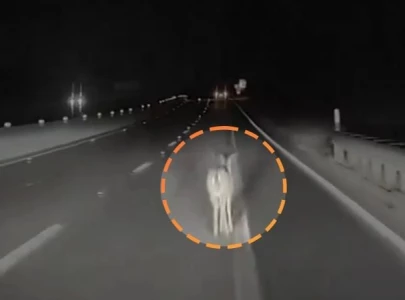

A Tesla equipped with Full Self-Driving (FSD) software struck a deer standing in the middle of the road, raising renewed concerns about the technology’s safety limitations.
Dashcam footage shared by the driver, identified only as Paul S, reveals the Tesla driving down a clear two-lane highway at night when the deer appeared suddenly in its path. Despite the vehicle’s advanced FSD mode, it failed to slow down or avoid the animal, hitting the deer directly without any apparent response from the car’s obstacle-detection system.
"Huge surprise after getting a dozen false stops every day!" Paul remarked, referencing the frequent, often unnecessary halts FSD reportedly triggers for non-existent obstacles. However, in this instance, the system missed a real threat. Paul did not disclose the exact time, location, or Tesla model involved, but images indicate that the impact left visible dents and scratches on the vehicle’s hood.
Tesla's FSD relies on a suite of cameras, mounted around the car, to detect obstacles and alert drivers. However, unlike some automated driving systems that incorporate sensors such as radar and sonar, Tesla's FSD is limited to visual data alone. On the night of the crash, it appears the FSD cameras failed to identify the light-colored deer against the similarly colored pavement, bypassing both the vehicle’s Forward Collision Warning and any evasive maneuver.
Paul, who shares his experience on social media as @TheSeekerOf42, later posted his thoughts on the incident, noting how the Tesla structure had managed the impact: "I’m insanely grateful to Tesla and Franz von Holzhausen for how well the vehicle structure handled the impact! I mean, that poor creature could’ve easily gone through the windshield, sending me to my ancestors.
But it held." However, he also voiced concerns about the damage, reporting that "the hood shifted almost an inch toward the windshield, which is cracked and scratched from the deer rolling across it and onto the side, leaving parts on the mirror." He added, "I'm worried the frame under the plastic is bent."
Despite the collision, Paul remained supportive of the FSD software, attributing the incident to an “edge case” where the system might need further adjustment. "FSD works awesome! This is just an edge case. We probably just need to teach FSD what a deer’s butt looks like," he added, injecting humor into the situation.
Tesla’s use of cameras instead of radar or LiDAR has long been a point of contention. Musk’s decision to rely solely on cameras is a cost-saving measure and reduces the number of components in the vehicle, as noted by former Tesla AI chief Andrej Karpathy in a 2022 interview. Musk has repeatedly voiced his opposition to LiDAR, calling it a “crutch” for self-driving technology.
Critics argue that this aversion to LiDAR puts Tesla at a disadvantage compared to competitors like Waymo, which employ LiDAR to create 3D maps of surroundings and achieve higher levels of autonomy. Jalopnik, an automotive news outlet, suggests that sensors capable of detecting three-dimensional objects might have detected the deer before the impact.
Tesla’s FSD system is already under scrutiny following multiple reported incidents, including a fatal crash last year involving a 2021 Tesla Model Y that struck a pedestrian in Rimrock, Arizona. As investigations continue, this latest incident fuels the ongoing debate over Tesla's approach to autonomous driving technology.